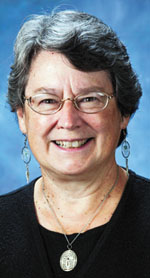By Corinne Winter

Last month in this column, I reflected on the continuing and urgent call to ecumenical dialogue. One of the themes of ecumenical dialogue is unity in diversity. It’s a phrase familiar enough today to have become a kind of cliché. And yet, it raises an important question. How do difference and unity fit together and support one another? That question may garner instinctive responses from a couple of perspectives. However, a couple of weeks ago, an article in this paper pointed out one kind of diversity that has long existed within the Catholic Church and of which many people remain unaware: a diversity of liturgical and spiritual traditions. The article in the Messenger told of an upcoming celebration of a Byzantine Catholic liturgy. That celebration recalls the assertion found in Lumen Gentium that a legitimate diversity of liturgical and spiritual traditions not only exists within the Catholic Church but contributes to its unity (see LG 13).
The Catechism of the Catholic Church lists seven rites, several of which actually include several rites within them: Latin, Byzantine, Alexandrian, Armenian, Maronite, and Chaldean (CCC1203) and asserts both that the diversity of rites are the result of the Church’s mission to all peoples and that “The mystery of Christ is so unfathomably rich that it cannot be exhausted by its expression in any single liturgical tradition (CCC1201).” Thus the diversity of expressions is described as supporting communion in faith. Furthermore, the different rites also have different governance structures and canon laws while remaining in communion with the pope through the Congregation for Oriental Churches.
The Decree on Eastern Catholic Churches (Orientalium Ecclesiarum) may be one of the lesser known documents to come from the Second Vatican Council, but it has some very important points for reflection. It lets us know that a certain diversity “in liturgy, ecclesiastical discipline, and in spiritual tradition (OE 3)” belongs to the Apostolic origins of the Church and is to be not only acknowledged but celebrated and preserved as supportive of the Church’s unity. It acknowledges that while the different churches originated due to the cultures and languages of different locations, they now sometimes co-exist in the same region — a situation that certainly increases with globalization and human migration in today’s world. It asserts the right and duty of the churches to preserve their distinct traditions for the good of the members (OE 5), and that members of the Latin rite who encounter Eastern rite Catholics in their ministry should be educated about those rites.
The decree encourages the establishment of governing and catechetical as well as parish structures to allow each baptized Catholic to preserve her/his own rite as much as possible and insists that any changes in a particular rite should support that rite’s organic development.
Could the principles outlined in Orientalium Ecclesiarum provide some guidance for us as we engage in ecumenical dialogue? It is important to note that throughout the document, the legitimacy of various rites is attributed to their ancient and apostolic origin. It would, therefore, require a great deal of discernment and prayer to understand how and to what extent that legitimacy might extend to newer developments. But it seems well worth the time and effort. Most of all, reading that document would keep us from thinking that every liturgical, spiritual, and disciplinary expression of the Catholic faith has been the same always and everywhere for all time. It cautions us against holding uniformity as a criterion of Catholicity.
It also seems valuable for those of us whose experience has been fairly limited to the Latin way of doing things to familiarize ourselves to some extent — whether by reading or by attending a Mass of another rite — with the way in which others express the same faith. Certainly, we don’t want simply to seek something different just for difference sake as we might in changing clothing or furniture. Rather, we want to enrich our understanding of our faith by learning the ways in which others understand it.
(Corinne Winter is a professor of theology at St. Ambrose University in Davenport.)







